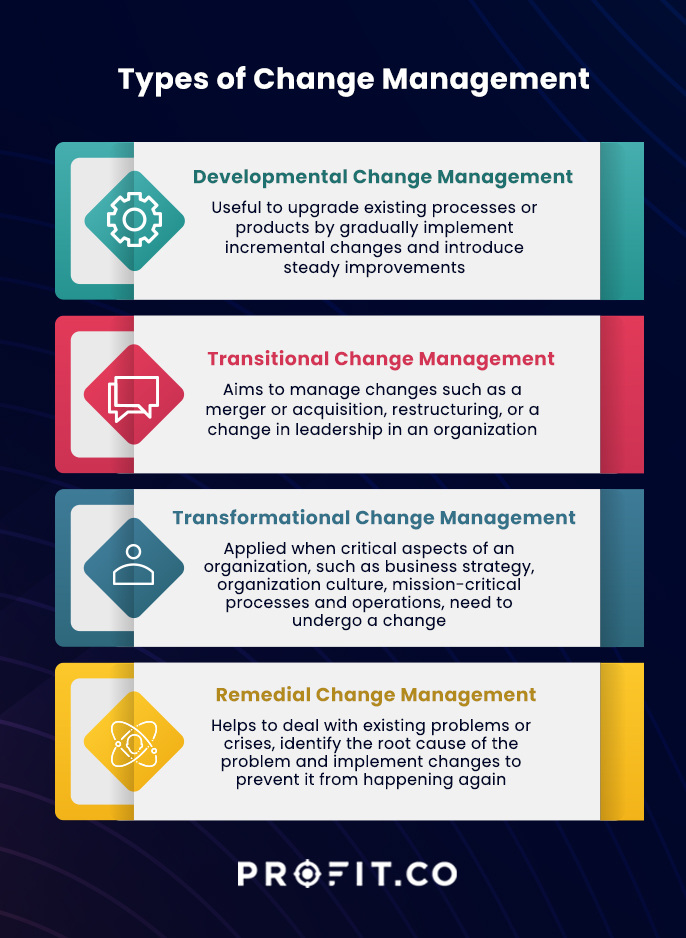Change is indispensable for any organization. A change enables an organization to adapt to varying conditions and changes in customer needs and expectations. It helps organizations transform and evolve over time in line with those changing conditions, demands, and expectations.
Lack of change or being slow to change can cause stagnation, loss of competitive edge, and leadership. It can lead the organization to fail to achieve its objectives and meet the expectations of its shareholders.
Read on to understand how change is the only constant on jump on to parts that interest you
Table of Contents:
Why Should an Organization Undergo Changes?
An organization should embrace constant changes in its processes, goals, or technologies to:
-
Stay relevant to the constantly evolving and new technologies and trends.
-
Increase efficiency by assessing its existing processes and technologies, identifying areas of improvement, implementing new solutions that increase efficiency and productivity, and achieving cost savings.
-
Embrace innovation by encouraging employees to think outside the box and contribute new ideas to maintain their leadership position and differentiate themselves from competitors.
-
Manage and mitigate risks through constant review and update of processes and technologies.
-
Improve employee engagement and job satisfaction, reduce turnover, and increase productivity by involving employees in the change process and making them feel invested in the success of the organization.
The need to manage change
Change is inevitable, but an organization cannot just “go with the flow” and adapt itself to the changing conditions. It requires careful planning, communication, and execution. Lack of change management can backfire and lead to negative impacts, including employee resistance, decreased productivity, financial losses, and damage to reputation.
For instance, if an organization indiscriminately cuts customer support in an effort to cut costs, or if the customer support goes offline for a few days due to a technology upgrade, it can cause chaos and lead to poor customer experience. It can have far-reaching negative consequences for the organization. Therefore, it is essential for organizations to actively manage change to ensure that they can carry it out in a smooth and effective manner with the least disruption possible. It calls for effective change management.
What is Change Management?
Change management is the process of planning, implementing, and monitoring changes in the processes, policies, or strategies of an organization to adapt to the changes in market or business conditions, embrace new and inevitable innovations, manage risks, or improve productivity, efficiency, and profitability, while minimizing any negative impact on employees, customers, and stakeholders.
The ADKAR model of change management
The ADKAR change management model is a framework that involves five steps.
-
Awareness: Before implementing a change, you should build awareness and communicate about the change, the reasons, and the potential benefits of the change.
-
Desire: Change is not a one-way process where the management forces a change and the entire organization undergoes it. You need to build consensus and participation from the employees. For that, you have to create a desire or willingness among employees to support the change by engaging employees, addressing their concerns and fears, and involving them in the change process. It will help build motivation and commitment to change.
-
Knowledge: Change requires a thorough understanding of what you need to do, what all you require to bring the change, and what outcomes the change would bring. You need to acquire and provide knowledge and information about the change. It involves studying facts and data, sharing information about the change and the expected outcomes, and assessing its impact on employees and the organization.
-
Ability: When you want a change, you should also have the ability to implement the change. For that, you should provide the necessary resources, skills, and tools for the implementation, such as skill development training and support and upskilling opportunities.
-
Reinforcement: The final step involves reinforcing the change by providing feedback, recognition, and rewards to encourage employees to sustain the change. You have to monitor and evaluate the change, celebrate your successes, and address any issues or concerns that may arise.

Start on Profit.co completely free today to help you on your change management journey

Other models of change management
In addition to the ADKAR model, there are other models of change management that are applicable to different scenarios. Following are some of the other change management models.
- Bridges’ Transition Model
- IT Infrastructure Library (ITIL).
- Kotter’s 8-Step Process for Leading Change
- Kurt Lewin’s Change Management Model
- McKinsey 7-S model
It is never too late to be who you might have been.
What are the Steps Involved in Change Management?
Change management usually involves the following steps.
1. Identify the need for a change
When you want to implement a change, it should have a rationale based on sound reasoning and a thorough analysis of various factors that necessitate the change. For instance, emerging technology may promise drastic improvements in the efficiency of operations in your industry/sector. Without embracing it quickly, you may face the risk of losing your competitive edge and market leadership. You have to understand and identify the need for the change, study the data and information about the technology, and foresee its implications on the organization.
2. Develop a change management plan
Before implementing a change, you should have clear, specific, measurable goals based on the information that you have and the research you have conducted. You need to clearly define the scope of the initiative, the scale of the change, timelines for the project, milestones, and most importantly, the resources required to make it a success.
For instance, in the aforementioned example, you may have to elaborate on how the new technology will improve your operational efficiency, come up with specific targets and relevant metrics to measure the improvement, define the steps involved in implementing this technology, create a project schedule, list out the milestones, calculate the total estimate of the project and the resources required, including human resources, training needs, infrastructure requirements, etc.
3. Communicate the change
Change requires uniform understanding and alignment across the spectrum, right from employees, suppliers, and business partners all the way up to the end customers. Robust communication is the only means to achieve that. For instance, if you are implementing a new customer support software and discontinuing the old technology, then you should communicate it to your customer support teams and the customers.
The extent of communication and the methods used to communicate with different stakeholders may vary according to the needs. For instance, your customer support teams will need training and support to adapt to the new system. So, you may have to customize the communication accordingly and communicate with them using internal social networks, newsletters, employee review meetings, etc. You may have to merely introduce the new UI to the customers and communicate its benefits using digital ads, personalized mailers, press ads, etc.
4. Forecast the impact of the change
Before implementing the change, you must assess and forecast its impact on various aspects of the organization and the stakeholders, such as employees, customers, and suppliers. You should also evaluate the benefits and the potential risks in implementing the change.
For instance, a change in incentive plans can impact the employee morale, productivity, and retention. You have to assess these risks in advance and produce accurate forecasts based on historical data on previous changes in incentives and corresponding changes in employee satisfaction levels, employee turnover rates in those periods, etc.
5. Implement the change
You have to implement the change carefully based on the plan, schedule, and timeline, using the allocated resources and budget. Changes like a new strategy execution reach the relevant stakeholders and the action plan concerning each stakeholder should be implemented in an order as per the timeline.
For instance, a change in your business system may need the involvement of your IT team with the software provider to install and successfully deploy the system. Successful deployment of the system can be a milestone, and only after reaching that you can train the employees of the concerned departments on how to use the system, change their processes and achieve better results with the system.
6. Monitor and evaluate the change
The change needs to follow the plan and achieve its objectives. Any deviations, mistakes, missteps, lack of resources, or unforeseen challenges should be identified and addressed immediately. For that, you need to constantly monitor and evaluate the effectiveness of the change management. You can monitor the change initiative by measuring the selected performance metrics and collecting feedback from various stakeholders.
As mentioned in the above example, if you are implementing a new incentive plan, you can measure employee engagement levels, employee satisfaction, employee turnover, employee retention rate, and other relevant metrics to verify the impact and compare it with your forecasts. You can also conduct surveys among employees and get their feedback through internal social media, one-on-one meetings, weekly review meetings, etc.
7. Make the change last
It is crucial to sustaining the change to ensure its success. For that, you should constantly monitor and evaluate the performance metrics, provide ongoing training and support for employees, and ensure continuous improvement of the processes.
For example, a newly implemented Customer Relationship Management system may necessitate ongoing training and support for employees, periodic evaluation of the program’s impact on productivity, customer experience, customer retention rate, etc., and adjustments as needed to ensure the ongoing success of the new system.
By following these steps and adopting a structured approach in change management, the organization can ensure that the implementation of the change is successful in the long term, the outcomes are in line with the expectations, and the organization realizes the benefits it hoped to achieve. Additionally, this approach can help minimize employee resistance and reduce disruption to the business.
Change Management Examples
Following are some scenarios that require change management.
-
Implementing new software systems across an organization
-
Restructuring the company to streamline operations
-
Merging with or acquiring another company
-
Shifting to remote work or hybrid work model
-
Introducing a new product or service
-
Implementing new processes or procedures
-
Moving to a new location or office space
-
Adopting new technology or hardware
-
Changing leadership or management structures
-
Reducing or expanding the workforce
Types of Change Management

4 Types of Change Management
Change management can be classified into four different approaches based on the nature of the change. They are:
1. Developmental change management
Developmental change management is designed to improve or upgrade existing processes or products. It helps to gradually implement incremental changes and introduce steady improvements to ensure that the organization keeps up with its competition and evolving market demands. For instance, if you offer a software solution, the customers expect feature and functionality upgrades at regular intervals. Upgrading your software and improving its functionality is essential to keep customers happy and competition at bay. Developmental change management enables you to deliver that on a consistent basis.
2. Transitional change management
When your organization goes through a drastic or radical change, such as a merger or acquisition, restructuring, or a change in leadership, you need transitional change management. Such changes bring a massive impact on the organization and impact all the stakeholders and customers. Transitional change management aims to manage that.
3. Transformational change management
Transformational change management makes sense when the critical aspects of your organization, such as business strategy,strategy implementation, organization culture, etc., or its mission-critical processes and operations, need to undergo a change. Transformational change management is often initiated in response to external pressures, such as changes in the market, customer demands, or technological advancements.
For instance, the emergence of AI has caused considerable shifts in various aspects of the business, and businesses have to integrate it into relevant processes to improve productivity, efficiency, and profitability. If you run an e-commerce store and if your competition is integrating AI in inventory management, then your products may be out of stock for much longer, compared to your competitors. Failing to respond with your own AI integration strategy through transformational change management can erase your competitive edge, and you may lose your customers to the competition.
4. Remedial change management
Remedial change management helps you address an existing problem or crisis. It enables you to identify the root cause of the problem and implement changes to prevent it from happening again. For instance, if you have an unacceptable number of manufacturing defects, remedial change management would help you identify the reasons, such as lack of training or inadequate resources, and address them.
Top 13 Benefits of Effective Change Management
Change management provides numerous benefits to organizations, including:
-
Efficiency: Change management can help organizations identify and address the inefficiencies in their processes, enabling them to achieve and sustain their productivity and efficiency in line with the expectations.
-
Employee Engagement: Change management requires active involvement and participation of the employees in the change process; it also provides them with the resources and support. It creates an enabling environment to increase employee engagement and satisfaction.
-
Communication: Communication is key to achieving a uniform change across the organization. Change management provides a structured framework for communicating changes to employees, customers, and other stakeholders. It helps to achieve alignment and clarity, and reduces confusion and uncertainty.
-
Reduced resistance to change: Change management addresses employees’ concerns and fears. It provides the awareness and support required to reduce resistance to change and increase acceptance and adoption.
-
Risk management: Change management helps organizations identify and manage potential risks in bringing inevitable changes. It reduces the likelihood of getting negative outcomes.
-
Innovation: Change management addresses the hesitations in adopting new ideas and approaches and helps inculcate a culture of creativity, innovation, and continuous improvement in organizations.
-
Customer satisfaction: Change management ensures constant improvement of products and services. It improves efficiency and customer service and ultimately helps in improving customer satisfaction and loyalty and thereby increasing the customer satisfaction score of the organization.
-
Adapting to changing conditions: Change management helps organizations adapt to new trends, technologies, and customer demands and become flexible enough to weather changing market conditions. As a result, the organization can stay competitive in the long run.
-
Standardized approach: Change management produces learnings from implementing and managing a change in an organization and standardizes the approach. These can be improved, adapted, and applied to various change projects across the organization. When you have a proven strategy to implement change, you can use the standardized template to replicate your success repeatedly and sustain your competitive advantage. This approach also enables you to improve the documentation of enterprise systems.
-
Empowerment: Change management helps employees become adaptable to changes and enables them to navigate the changes faster. It not only empowers individuals and employees but also makes the organization as a whole more flexible.
-
ROI: Change management ensures the successful implementation of changes, allowing organizations to find ROI on their transformation projects.
-
Forecasting and focusing on the right priorities: Change management forecasts a change and captures its impact and implications across the organization. As a result, you have a baseline regarding what you need to achieve, which enables you to focus on the right things and achieve great alignment between the goals of your change and your outcomes. Change management makes sure that there are no unpleasant surprises like scope creep when you implement change.
-
Understanding of systems and processes: When you implement change management, you need a great understanding of the areas that you may be subject to change. You also have to study in detail the far-reaching implications of the change. As a result, you get to understand your existing systems and processes more, and you can better identify the areas that need improvement and efficiency.
What are the Challenges of Change Management?
5 key challenges in implementing change management.
1. Resistance to change
Resistance to change is one of the most commonly occurring challenges in change management. Changes often impact employees and other stakeholders in the organization. So they naturally resist change due to the potential increase in workload and the fear of how their work might be impacted. So it is essential to convince the employees, invite their feedback, ensure transparency and provide necessary training and resources so that they can adapt to the change without difficulty.
2. Disruption of work
When you implement radical new technologies, you may have to rethink your processes and workflows. It can disrupt work, and you have to plan change management accordingly so that the change is gradual, causing minimal disruption.
3. Managing resources
Changes involve managing various kinds of resources, from human resources to data, infrastructure, and financial resources. It requires a great deal of planning and judicious use of resources to prevent mistakes that can easily trigger a chain reaction leading to the failure of the change project.
4. Inclusion and Transparency
You could communicate the change initiatives with all the stakeholders and consider the diverse views of the employees to ensure the adoption, buy-in, and success of the change initiative. Further, you have to customize communication with various stakeholders and communicate with them through different channels. It requires a comprehensive communication plan to implement change management successfully.
5. Sustaining the change
Organizations often manage to make short-term changes succeed. But long-term change is more complex as it needs to be continuously monitored, adjusted, and sustained by planning timelines and milestones well in advance. The longer a change takes to get implemented, the more likely it is to run into mistakes, missteps, and failures.
Conclusion
Change Management is not an individual or department-only process — but is always a company-wide initiative that needs input and action from all sides of the business. It requires proper goal-setting, excellent planning, setting clear expectations, team management, implementation, and constant measurement for it to be effective.

Ready to start your OKR journey to help you with your change management today?


